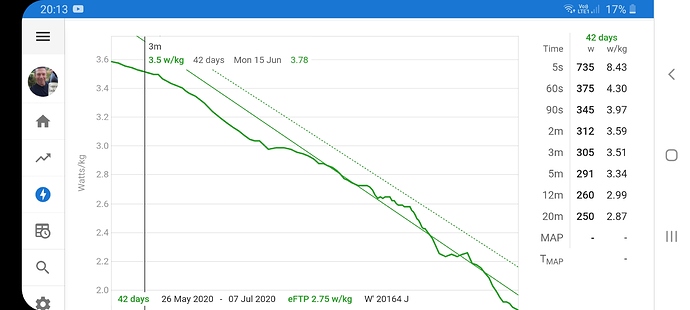Your power curve needs to come down from above and it the dotted line to count. I think you need to do some max shorter efforts (5m or less) to get a number.
Like @david said, yo have to do a all out 5min effort.
Yes this makes sense as it will move my curve up, maybe I just misinterpreted the reply as it doesn’t read very well grammatically. I think “and it” isn’t meant to be there. Thanks
Probably should read “and hit” 
Ah yes, thanks, couldn’t fathom what was meant ![]()
With the add of VLamax to WKO5 there has been a bump in topics on this subject. Is there finally a proof somewhere that this strategy repeated everywhere by Sebastian Weber is right with real people feedback ? thanks
I use WKO5 and test to keep my PDC data current. When my FTP gets to 83% of the WKO5 pVo2 max estimate, if my goal requires higher FTP or higher pVo2 (for e.g. certain track races), I consider doing some Vo2 max efforts a week for a couple of weeks to ‘raise the ceiling’. If my goal is best acheived by longer time to exhaustion (TTE) at FTP or greater stamina rather than pure higher power (road races, gravel races, sportifs), I continue to try to ride longer at the current FTP to extend TTE and only do a smaller amount of Vo2 max efforts.
Fascinating discussion on the impact of utilizing different training cadences! I particularly appreciate the conversation around balancing high and low cadence to optimize fat burning and muscle endurance. The notion that self-selected cadence might be most beneficial, while exploring wider cadence ranges to improve efficiency, resonates with my own experience.
I’ve experimented with low-cadence sessions to build muscle strength and high-cadence work to enhance endurance and fatigue management. This has helped me become a more versatile cyclist, capable of adapting to various racing scenarios.
I’m curious about how others incorporate cadence into their training, especially in terms of specific preparation for races with varied elevation profiles. Have you found a marked benefit in favoring lower or higher cadences during certain phases of your training?
